Maintenance/Mouse button replacement
Background and problem
I'm your ordinary sort of office worker, one who types and clicks far too often in the course of a day as if this digital thwacking were my only form of exercise. Various body parts connected to these devices are getting old and very much appreciate the mid-range ergonomic keyboard and mouse generously granted by my employer. Office workers of the world, you are advised to ask for at least this much.
Maybe I've become too emotionally attached to these tools. I feel fancy that someone once spent a hundred euro on my well-being. Or maybe it's all a performance of longevity as this job becomes a career—like a delivery driver who hangs a pair of fuzzy dice over the rear-view mirror to announce that they were once cool, or an academic whose bookshelf holds all the back issues of a professional journal. Either way, I begin to fade when I'm separated from the mouse and keyboard.
The mouse trouble began when I moved into my "home office"—the mouse lives on a homemade standing desk not much bigger than a cutting board, screwed to the wall at navel height where I can accidentally bump into it as I stumble out of bed. This is also the ideal height for an extremely destructive impact of any plastic-encased electronics unlucky enough to fall to the floor. My mouse has suffered a thousand of these shocks and its once-noble exterior is held together by a combination of gravity and only a handful of the fasteners it was born with. But it still clicks!
At least, it clicks most of the time. When I first noticed an issue with the clicking, I rushed into the denial stage of grief and just clicked a bit harder every time, until the charade wore thin. It's not fun to jab at a mouse with maximum force every time, and even less fun when it might take two or three attempts to get a click. This inconsistency really starts to burn when double-clicking—an ableist caprice under normal circumstances but a fool's errand for a fool whose buttons are iffy. Then there was the hot minute for which I imagined I had worked around it by software-mapping the right and left buttons to one another, holding the mouse in a funny way so that both pointing fingers reach across to what used to be the right-hand button. Devious games like this are causing my habits to cross-wire too, so I end up right-clicking on the trackpad, on other computers, and worst of all I found that the right button becomes increasingly important according to how unusable it is.
Maybe I could have adopted another mouse but the manufacturer cleverly shipped it as a bundle with the keyboard. These two and the USB dongle are a happy little nuclear family, and nothing but the unhappiest e-waste if separated.
I'd really like to make the mouse work again for the sake of the planet if nothing else.
Pop the hood[1]
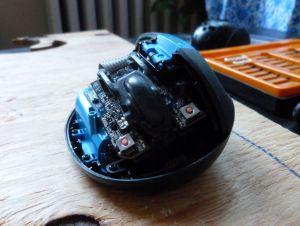
I started the repair by measuring missed clicks with the linux utility xev [2], which showed that the buttons had become sensitive to the exact orientation of my finger. Only a downward-and-rightwards press would have an effect. Either something was wrong with the alignment of the broken plastic parts, contact material was worn off of the internal switch, dust sand and chips had gotten into the sealed part, or all of the above. First thing to do is just to disassemble and reassemble. Next, I cleaned it by wiping out the stray lint, squirting canned air at all the moving parts and flooding the heart of the buttons with isopropyl alcohol, finishing off the routine by squinting my eyes and imagining very hard that I had fixed the issue, yet nothing changed. Even with the cover off, the buttons behaved badly.
Still feeling stubborn though beginning to accept fate, I planned to replace the standard microswitches, the little silver squares with an orange dot in the middle which are pressed by plastic stems inside of the buttons. These switches come in exactly the same vanilla flavor that has been made since long before this particular mouse was dreamed up ten years ago. All 8 solder points are accessible as you might see in this image, so it shouldn't be a challenging fix.
I was able to confirm that the switches have the same pinout and footprint as their potential replacements, although the proof will not be definitively in the pudding until the switches are isolated from their circuit.
Two fellow Earth defenders on my office's IT Team ordered the new switches and encouraged my bravado, and I barely remember the next couple of weeks of missed clicks.

What could possibly go wrong?
The old switches need to be desoldered but the geometry of a four-legged chip is slightly annoying. I believe that the right tool to lift both legs on one side or all four legs at once would have been a two-headed iron like soldering tweezers, or a rework station with a hot air gun. Desoldering the legs one at a time with the regular soldering iron is hard to do. I turned to the infinitely versatile metal thumbtack to apply some pressure to the switch body as I heated up each pad in turn.
In hindsight, the main lesson I relearned is that coffee mixes poorly with fine motor tasks. My hands were trembling like leaves in wind, and I probably used ten times the force that I should have when pushing the thumbtack under the switch. I also should have pried only at the legs and not at the body of the switch itself, if possible.
What I'm trying to get around to telling you, gentle reader, is that I tore away half of the important little electrical traces during this step.
Here are some photos of the damage:

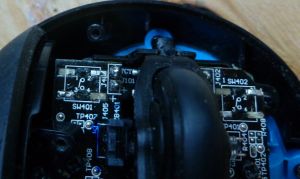
It's similar to discovering that bits of a placenta are missing after birth: inspect everything that came out, if it's intact then you're probably good. If something is missing then assume it's going be a serious problem and don't continue without finding out exactly what went wrong.
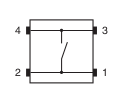
Nonetheless, I thought I would try to finish the replacement as planned.
After all, the internal wiring for these switches has the left and right pads tied together internally so it's possible that we only needed one pad conducting the signal and the other had no traces anyway, it's purely there for mechanical attachment. This could also explain why the same pads tore away on both switches?
The new switches went in without too much fuss.
I should mention at this point that I'm a complete hack—an unlicensed hobbyist. I was let go from a summer job working for a hardware video artist at which I made 10,000 solder connections, decades ago. Honestly, flashbacks from this experience came to me against my wishes, singeing my conscience with a cloud of lead smoke as I sweat over the two small switches.
Okay but it went uneventfully and here is the result, notice the handsome new slate-gray nubs.
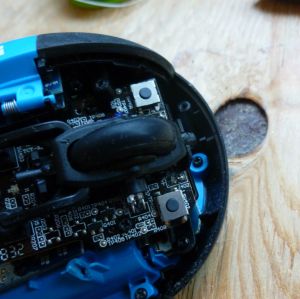
There was a slight height difference between the old and new switches, so I prepared to shave down the plastic step which does the internal pressing. The mechanical clickiness felt great.

However, this is where the story takes a sad turn: there was no signal sent from either button. They are dead to the computer, and a multimeter confirms nothing is happening on the board.
This is the point at which my photographer suddenly gets distracted by the pretty trees outside of our window and mercifully snaps a few photos of that, instead of zooming in on my fallen expression and the tears running down my cheeks, as a more seasoned journalist might have done.

Nothing to lose but our chains
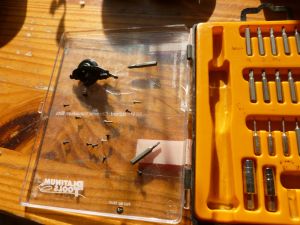
Time to go deep. Take apart the everything and find out what I broke. I'd rather leave the switches in place, they seem good enough mechanically and I'll probably just tear away the remaining traces if I touch them again. Instead, there's got to be a way of rerouting the signals that went to the missing surface-mount pads. A continuity tester confirms that the other working buttons do what we might expect: one side has a positive voltage and the other side causes a wire in the board connector to toggle between high-impedance and positive reference. The broken buttons don't cause a similar signal anywhere on the board connector, and it's hard to follow the traces because of the high-security board layout and black solder mask.
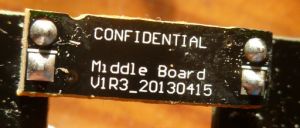
Oh, hold everything! The middle board is clearly marked "confidential", we'll have to stop here because it's simply not allowed. (I jest.)
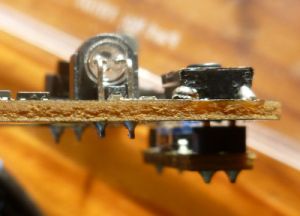
Looking at the edge of the PCB shows that it's only two layers so everything that happens is on the front and back. Electrical networks can only cross through the board via a via, go sideways along a trace of foil, or through a component. Nonetheless, I can't quite follow the signal. Now we're going to have fun: I make a test jumper ending with a small resistor to avoid a high-current short, clip it to the positive reference voltage on a working switch, and poke this into each conductor of the board connector one at a time with the mouse powered on. Xev begins to reveal the confidential secrets.
Luckily for me, this is successful! It becomes clear which of the switch pads should carry positive voltage and which board connector wires relay the outgoing button signals.
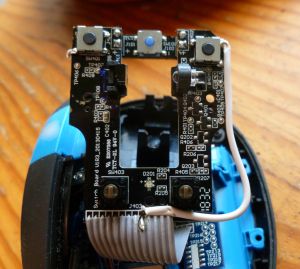
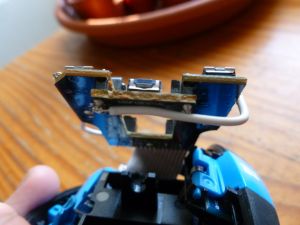
In the end it only takes two additional wires to make the mouse fully functional. Photos are included for your amusement. The top jumper looks especially scary since it attaches to an unusual hole cut in a ribbon cable, but both wires make me slightly queasy.
I would file this hack under the "I'll jam the satellite uplink with my hair clip while you break into the broadcast station with a chainsaw" school of electrical engineering, and the resulting monstrosity is a fire hazard without a doubt. I wouldn't feel comfortable letting anyone else use it. But it's good enough for me!
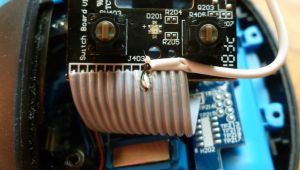
Here's a close-up of the most absurd detail, where I scraped away at the ribbon cable insulation to more easily patch in—kids, please don't try this at home.
Notes
- ↑ I don't own a car nor do I condone their use but did I grow up in California, USA so everything comes with a car metaphor.
- ↑ https://www.x.org/releases/X11R7.7/doc/man/man1/xev.1.xhtml
